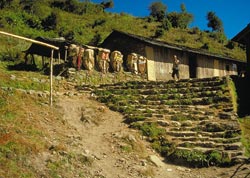 Clothing Clothing
Clothing depends on your visiting areas and time, however, it is recommended to have both light and warm clothing in the mountain areas or in Kathmandu Valley. Preferable to bring warm clothes (Nov-Feb) especially for the groups going to higher altitude; The color preference should be for khaki or green \beige \brown clothing, as this could greatly enhance the chances of seeing wildlife in National Parks. Among spare clothing, several thinner layers are better than one thick layer in addition of rain gears, sun protections are advisable. For footwear flat soled shoe for city sight seeing, and walking boots with good tread & ankle support is best. No transparent clothes or shorts for women are acceptable in this society. However, shorts are acceptable for men when walking out. But going without a shirt is not appreciated.
In Kathmandu. Casual clothes are the rule, unless you get invited to a formal Nepal government or embassy reception.
Equipment
Equipment check list that follows details the equipment you will need for your trek. Most of these items are available for rent or sale in Kathmandu., but all trekking equipment in Nepal is either used equipment that was sold by other trekkers or mountaineering expeditions or locally made reproductions of internationally known brands.
Equipment Check List:
• Jeans or slacks
• Towel and toilet kit
• Underwear
• Gloves or mittens
• Sleeping bag, warm to 20 degrees F, either down or fibrefill (or you can rent one in Kathmandu.)
• Parka, down or fibrefill; a ski jacket is ok
• Sweater, wool shirt or acrylic pile jacket.
• Duffel bag, canvas or nylon, without a frame (for porters to carry)
• Daypack or rucksack, waterproof, for you to carry Water bottle 1 litre or 1 quart; be sure that it does not leak.
• Flashlight or headlamp, Walking shoes: either boots, light hiking or running shoes, well broken in. As there may be rain, mud or snow; boots are sometimes necessary therefore you should bring them despite the extra hassle. Many times the entire trek can be done in tennis shoes, but if there is snow, you run the risk of frostbite, or at least cold feet if you do not have boots. If your feet are small (size 10 or less), you can rent boots in Kathmandu.
• Hats, one with a brim for sun; one wool for cold weather.
• Sunglasses or goggles - very important for travel above 12,000 feet. Absolutelyessential for Everest treks, optional for Annapurna treks (though they may be necessary in December and January when thereis snow).
• Shorts - it may be warm during the day, especially near Pokhara. You will probably not wear shorts on Everest treks.
• Women should wear skirts instead of shorts.
• Socks - two or three pairs thick wool or artificial fibre.
• Shirts - three are recommended: two T shirts and one long sleeve shirt.
• Pocket knife (Be sure this is packed in your checked baggage to avoid hassles with airport security).
• Rainwear - a poncho; or you can buy an Indian umbrella in Kathmandu. for about $2.
• Slippers or sandals for campsite wear. Rubber "shower shoes" are available in Kathmandu.
|